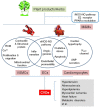Chinese Herbal Medicine on Cardiovascular Diseases and the Mechanisms of Action
- PMID: 27990122
- PMCID: PMC5130975
- DOI: 10.3389/fphar.2016.00469
Chinese Herbal Medicine on Cardiovascular Diseases and the Mechanisms of Action
Abstract
Cardiovascular diseases are the principal cause of death worldwide. The potentially serious adverse effects of therapeutic drugs lead to growing awareness of the role of Chinese herbal medicine in the treatment of cardiovascular diseases. Chinese herbal medicine has been widely used in many countries especially in China from antiquity; however, the mechanisms by which herbal medicine acts in the prevention and treatment of cardiovascular diseases are far from clear. In this review, we briefly describe the characteristics of Chinese herbal medicine by comparing with western medicine. Then we summarize the formulae and herbs/natural products applied in the clinic and animal studies being sorted according to the specific cardiovascular diseases. Most importantly, we elaborate the existing investigations into mechanisms by which herbal compounds act at the cellular levels, including vascular smooth muscle cells, endothelial cells, cardiomyocytes and immune cells. Future research should focus on well-designed clinic trial, in-depth mechanic study, investigations on side effects of herbs and drug interactions. Studies on developing new agents with effectiveness and safety from traditional Chinese medicine is a promising way for prevention and treatment of patients with cardiovascular diseases.
Keywords: Chinese herbal medicine; atherosclerosis; cardiovascular diseases; dyslipidemia; heart disease; hypertension.
Figures

Similar articles
-
Chinese Herbal Compounds for the Prevention and Treatment of Atherosclerosis: Experimental Evidence and Mechanisms.Evid Based Complement Alternat Med. 2015;2015:752610. doi: 10.1155/2015/752610. Epub 2015 May 18. Evid Based Complement Alternat Med. 2015. PMID: 26089946 Free PMC article. Review.
-
Multidirectional Intervention of Chinese Herbal Medicine in the Prevention and Treatment of Atherosclerosis: From Endothelial Protection to Immunomodulation.Am J Chin Med. 2024;52(4):925-947. doi: 10.1142/S0192415X24500381. Epub 2024 May 27. Am J Chin Med. 2024. PMID: 38798151 Review.
-
Traditional Chinese medicine and mitophagy: A novel approach for cardiovascular disease management.Phytomedicine. 2024 Jun;128:155472. doi: 10.1016/j.phymed.2024.155472. Epub 2024 Feb 24. Phytomedicine. 2024. PMID: 38461630 Review.
-
Could the gut microbiota reconcile the oral bioavailability conundrum of traditional herbs?J Ethnopharmacol. 2016 Feb 17;179:253-64. doi: 10.1016/j.jep.2015.12.031. Epub 2015 Dec 23. J Ethnopharmacol. 2016. PMID: 26723469 Review.
-
Treatment of Insomnia With Traditional Chinese Herbal Medicine.Int Rev Neurobiol. 2017;135:97-115. doi: 10.1016/bs.irn.2017.02.006. Epub 2017 Apr 3. Int Rev Neurobiol. 2017. PMID: 28807167 Review.
Cited by
-
Ganoderma lucidum spore ethanol extract attenuates atherosclerosis by regulating lipid metabolism via upregulation of liver X receptor alpha.Pharm Biol. 2020 Dec;58(1):760-770. doi: 10.1080/13880209.2020.1798471. Pharm Biol. 2020. PMID: 32780606 Free PMC article.
-
Potential Therapeutic Mechanism of Scutellaria baicalensis Georgi against Ankylosing Spondylitis Based on a Comprehensive Pharmacological Model.Biomed Res Int. 2022 Dec 21;2022:9887012. doi: 10.1155/2022/9887012. eCollection 2022. Biomed Res Int. 2022. PMID: 36588535 Free PMC article.
-
Assembly and Annotation of a Draft Genome of the Medicinal Plant Polygonum cuspidatum.Front Plant Sci. 2019 Oct 18;10:1274. doi: 10.3389/fpls.2019.01274. eCollection 2019. Front Plant Sci. 2019. PMID: 31681373 Free PMC article.
-
Therapeutic Effects of Traditional Chinese Medicine on Cardiovascular Diseases: the Central Role of Calcium Signaling.Front Pharmacol. 2021 Jul 9;12:682273. doi: 10.3389/fphar.2021.682273. eCollection 2021. Front Pharmacol. 2021. PMID: 34305595 Free PMC article. Review.
-
Kansuinine A Ameliorates Atherosclerosis and Human Aortic Endothelial Cell Apoptosis by Inhibiting Reactive Oxygen Species Production and Suppressing IKKβ/IκBα/NF-κB Signaling.Int J Mol Sci. 2021 Sep 24;22(19):10309. doi: 10.3390/ijms221910309. Int J Mol Sci. 2021. PMID: 34638650 Free PMC article.
References
-
- Andreadou I., Iliodromitis E. K., Mikros E., Constantinou M., Agalias A., Magiatis P., et al. (2006). The olive constituent oleuropein exhibits anti-ischemic, antioxidative, and hypolipidemic effects in anesthetized rabbits. J. Nutr. 136 2213–2219. - PubMed
-
- Andreadou I., Mikros E., Ioannidis K., Sigala F., Naka K., Kostidis S., et al. (2014). Oleuropein prevents doxorubicin-induced cardiomyopathy interfering with signaling molecules and cardiomyocyte metabolism. J. Mol. Cell. Cardiol. 69 4–16. - PubMed
-
- Asgary S., Naderi G. H., Sadeghi M., Kelishadi R., Amiri M. (2004). Antihypertensive effect of Iranian Crataegus curvisepala Lind.: a randomized, double-blind study. Drugs Exp. Clin. Res. 30 221–225. - PubMed
Publication types
LinkOut - more resources
Full Text Sources
Other Literature Sources

